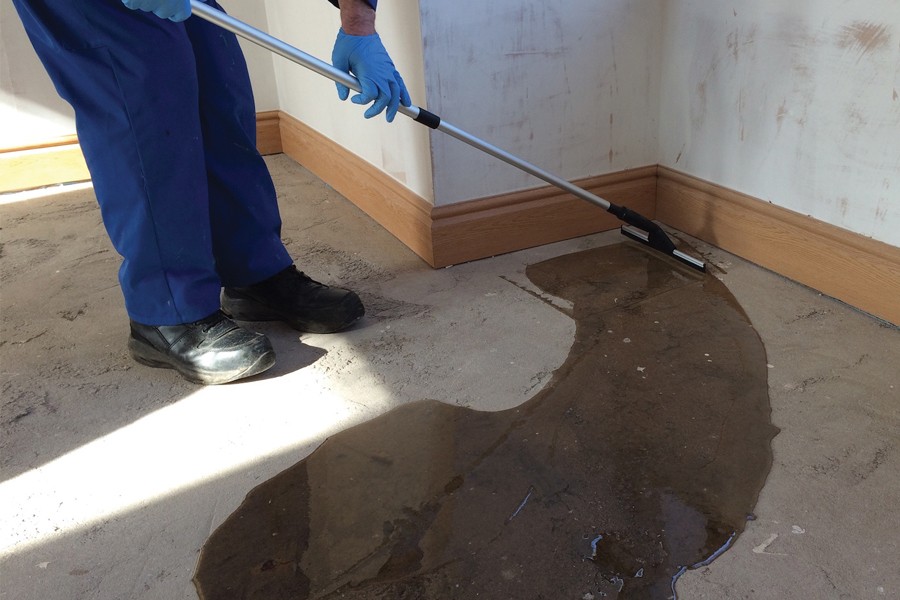Neil Sanders details the main issues to anticipate and how to deal with them when it comes to removing old floorcoverings.
WHEN undertaking installations as part of a refurbishment, you never know what you are dealing with until you actually remove old floorcoverings. Flooring contractors will frequently encounter a number of challenges that they’d be less likely to find in newbuild settings, including dealing with damaged or contaminated subfloors.
Damaged subfloors
On removing old floorcoverings as part of a refurbishment, contractors may discover that the subfloor is cracked or damaged. This needs to be addressed before proceeding to the next stages of subfloor preparation. Where screeds are very badly damaged, mechanical repair of the subfloor may be necessary.
The appearance of cracks should always be investigated in case there is an underlying issue that may result in floor failure. In most cases, dormant, non-structural cracks, or holes as deep as 50mm can be filled with a repair compound. Some levelling compounds can also be filled up to 50mm when graded aggregate is added and the water content in the mix reduced.
Where excess subfloor moisture is detected, contractors should use a repair compound that is designed for use in damp conditions, such as F Ball’s Stopgap 460 Exterior Repair, prior to the application of a waterproof surface membrane. Stopgap 460 is weather-resistant, so it can also be used to repair external floors as part of refurbishment projects.
Moisture management
Contractors need to be aware of the problems posed by damp when installing floorcoverings, particularly when refurbishing floors in old buildings.
Excess levels of subfloor moisture can result in moisture rising up and attacking adhesives and floorcoverings, possibly causing complete floor failure. Building regulations introduced in 1965 made it a legal requirement to install a structural dampproof course in new buildings, so damp is more likely to be a concern in buildings built before this time.
Even if a dampproof course is present, contractors should always conduct a moisture test to determine subfloor moisture levels before proceeding, least of all because the dampproof course may have been compromised at some point in the building’s history.
Where a moisture test indicates that subfloor relative humidity (RH) levels are above 75% (65% if wood floorcovering are going to be installed), a waterproof surface membrane will be required to suppress excess subfloor moisture levels.
Epoxy waterproof surface membranes are available that will isolate excess subfloor moisture where relative humidity values are up to 98%, with a single coat application, and fully cure in as little as three hours.
Weak or friable screeds
It may also be the case that contractors find a sand/cement or calcium sulphate screed has a weak or friable surface – often the result of improper installation or curing techniques.
To avoid having to completely remove a weak or friable screed by mechanical means, it may be possible to treat it using a surface reinforcement system, such as F Ball’s Stopgap SRS, a two-component epoxy resin reinforcement material designed to quickly stabilise and reinforce weak sand/cement screeds. Contractors simply mix the components thoroughly, pour the mixture over the weak subfloor and spread out with a rubber squeegee, working into the surface until no more liquid is absorbed.
Stopgap SRS is fast-acting, meaning weak screeds can be reinforced overnight to provide a base suitable for the installation of subsequent subfloor preparation products.
Contamination
Old adhesive residues, such as bitumen and carpet tile tackifiers, may also be present after removing old floorcoverings. Traditionally, contractors would have to remove these completely by mechanical means before proceeding.
Recent innovations now offer an alternative time-saving solution: as long as adhesive residues are minimal and well bonded, contractors can apply a levelling compound that has been specially formulated for use over old adhesive residues, such as F Ball’s Stopgap 1200 Pro, a fast setting, fast drying product which can be used without priming beforehand, saving further time.
Subfloors may also be contaminated with oil, grease, or other chemicals. In this case, the surface will need to be removed using mechanical means before applying other floor preparation products. In the case that the subfloor is very badly contaminated, the screed may need to be completely replaced.
If this is not possible, an alternative is to install F Ball’s Stopgap Isolator Membrane, an impervious loose-lay sheet that can be laid over damp or contaminated subfloors prior to the installation of vinyl sheet, linoleum or rubber floorcoverings and bitumen backed carpet tiles.
Next steps
Once the subfloor is suitably sound, smooth, and dry, contractors can proceed with the installation of new floorcoverings. Where an isolator membrane has not been used, this should include the application of a suitable levelling compound to create a perfectly smooth base for the receipt of floorcoverings.
www.f-ball.co.uk
Neil Sanders is technical director at
F Ball and Co


